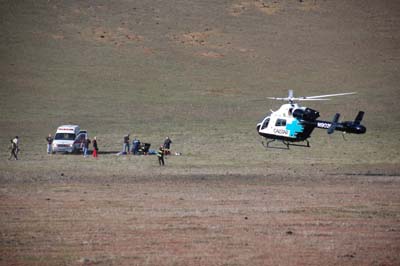Don’t think golf course. Think, maybe, golf trail.
SAN MARTIN – Don’t think golf course. Think, maybe, golf trail.
That’s the kind of vision that Santa Clara County Parks Department officials have unveiled for the new 18-hole golf course that will be the main development centerpiece proposed at Bear Ranch, the county’s huge swath of new parkland east of San Martin.
While final specifics aren’t nailed down yet, officials have shared visions of environmental stewardship in both the management and design of the new course – which will take up much of the most useable part of the ranchland, the 300-acre “Western flat” north of San Martin Avenue on the park’s western edge.
And based on those statements, the course has even drawn the cautious support of the county’s Audubon Society.
Although the society generally fought against the golf course concept through the months-long planning process, society officials told supervisors earlier this month that the local branch of the organization would support a course as long as it is indeed developed as an environmental model.
“They would be seen as a leader,” said Kelly Crowley, an advocate with Audubon’s Santa Clara County chapter. “They would have a very prominent environmental organization supporting a golf course. That doesn’t happen very often.”
Two major environmental problems with courses are typically pesticide use and loss of wildlife habitat, Crowley said.
While traditional courses may serve as open space, they don’t necessarily provide diverse types of wildlife habitat.
“With a golf course you have one or two kinds of grass and some ornamental trees that are typically nonnative trees,” Crowley said. “You get little songbirds and squirrels, and if you call it open space, well, it is one kind of open space but it’s not ecologically very valuable.”
To serve as an environmental model, the county will have to serve habitat restoration, Crowley said. The Spanish Bay golf course near Pebble Beach in Monterey County is a good example, she said, because designers restored sand dune habitat that was lost in the past due to other construction projects in the area.
“I’d anticipate something similar here where they’d incorporate habitat restoration, plant native grasses in between the greens and fairways and perhaps create some habitat for specific species …” Crowley said. “Whatever native species typically use that area, to the extent they can restore habitat and improve what’s been lost would be a goal of the project.”
Designers should also ensure they don’t cut down major oaks or other trees and ensure the new course largely follows the natural run of the land – rather than become a heavily graded area where hillsides are literally moved or flattened.
“An environmentally friendly course would avoid all of that dirt-moving,” she said.
The course should also attempt to use an “integrated pest management” approach to managing the landscape, Crowley said, where golf course managers try to use mechanical and biological methods to control pests as much as possible in a preventative sense.
If they do have to resort to chemical or pesticide use, managers have strict guidelines about the specific types of chemicals used – usually the least toxic possible – and where and how to use them.
Although specific design plans aren’t finalized yet, so far the county has described many of those features in discussions about the course.
Before county supervisors earlier this month, parks staff and design consultants described plans to incorporate native plant and grass restoration areas between fairways at the new course, as well as a buffer strip of native grasses along its western edge to preserve views from nearby roads.
“We’re looking to do something more in keeping with Monterey County,” said Parks Director Lisa Killough. “The idea here is to take an area that’s basically a degraded farmland – the habitat value of the land is pretty poor right now – and introduce some edge treatment to it …”
The county could also create some wetland environment to support not only terrestrial but aquatic species as well, she said.
Meanwhile, management of the course would be subject to a new county Integrated Pest Management Ordinance, she said.
“I think the really big deal is we’re looking to create a golf course without the use of chemicals,” Killough said. “The county would be kind of leading edge in that area. I’m not aware of too many courses in the country that are doing that right now. It’s kind of a big deal.”
Both Killough and Crowley agreed a model course would probably cost more than a traditional course.
“We’re assuming over time people will appreciate the value placed on an environmentally friendly environment,” Killough said.







